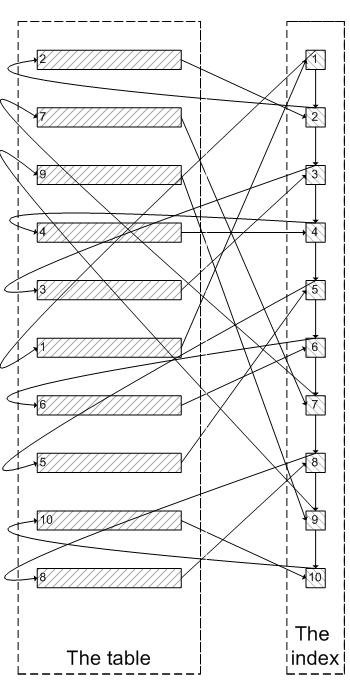一次SQL查詢優(yōu)化原理分析(900W+數(shù)據(jù)從17s到300ms)
目錄
- 前言
- 證實
- 參考資料:
有一張財務(wù)流水表,未分庫分表,目前的數(shù)據(jù)量為9555695,分頁查詢使用到了limit,優(yōu)化之前的查詢耗時16 s 938 ms (execution: 16 s 831 ms, fetching: 107 ms),按照下文的方式調(diào)整SQL后,耗時347 ms (execution: 163 ms, fetching: 184 ms);
操作:查詢條件放到子查詢中,子查詢只查主鍵ID,然后使用子查詢中確定的主鍵關(guān)聯(lián)查詢其他的屬性字段;
原理:1、減少回表操作;
2、可參考《阿里巴巴Java開發(fā)手冊(泰山版)》第五章-MySQL數(shù)據(jù)庫、(二)索引規(guī)約、第7條:
【推薦】利用延遲關(guān)聯(lián)或者子查詢優(yōu)化超多分頁場景。
說明: MySQL并不是挑過offeset行,而是取offset+N行,然后返回放棄前offset行,返回N行,那當(dāng)offset特別大的時候,效率就非常的底下,要么控制返回的總頁數(shù),要么對超過特定閾值的頁數(shù)進行SQL改寫。
正例: 先快速定位需要獲取的id段,然后再關(guān)聯(lián):
SELECT a.* FROM 表1 a,(select id from 表1 where 條件 LIMIT 100000,20) b where a.id = b.id;
-- 優(yōu)化前SQLSELECT 各種字段FROM `table_name`WHERE 各種條件LIMIT 0,10;
-- 優(yōu)化后SQLSELECT 各種字段FROM `table_name` main_taleRIGHT JOIN (SELECT 子查詢只查主鍵FROM `table_name`WHERE 各種條件LIMIT 0,10;) temp_table ON temp_table.主鍵 = main_table.主鍵
前言
首先說明一下MySQL的版本:
mysql> select version();+-----------+| version() |+-----------+| 5.7.17 |+-----------+1 row in set (0.00 sec)
表結(jié)構(gòu):
mysql> desc test;+--------+---------------------+------+-----+---------+----------------+| Field | Type| Null | Key | Default | Extra |+--------+---------------------+------+-----+---------+----------------+| id | bigint(20) unsigned | NO | PRI | NULL | auto_increment || val | int(10) unsigned | NO | MUL | 0 ||| source | int(10) unsigned | NO | | 0 ||+--------+---------------------+------+-----+---------+----------------+3 rows in set (0.00 sec)
id為自增主鍵,val為非唯一索引。
灌入大量數(shù)據(jù),共500萬:
mysql> select count(*) from test;+----------+| count(*) |+----------+| 5242882 |+----------+1 row in set (4.25 sec)
我們知道,當(dāng)limit offset rows中的offset很大時,會出現(xiàn)效率問題:
mysql> select * from test where val=4 limit 300000,5;+---------+-----+--------+| id | val | source |+---------+-----+--------+| 3327622 | 4 | 4 || 3327632 | 4 | 4 || 3327642 | 4 | 4 || 3327652 | 4 | 4 || 3327662 | 4 | 4 |+---------+-----+--------+5 rows in set (15.98 sec)
為了達到相同的目的,我們一般會改寫成如下語句:
mysql> select * from test a inner join (select id from test where val=4 limit 300000,5) b on a.id=b.id;+---------+-----+--------+---------+| id | val | source | id |+---------+-----+--------+---------+| 3327622 | 4 | 4 | 3327622 || 3327632 | 4 | 4 | 3327632 || 3327642 | 4 | 4 | 3327642 || 3327652 | 4 | 4 | 3327652 || 3327662 | 4 | 4 | 3327662 |+---------+-----+--------+---------+5 rows in set (0.38 sec)
時間相差很明顯。
為什么會出現(xiàn)上面的結(jié)果?我們看一下select * from test where val=4 limit 300000,5;的查詢過程:
查詢到索引葉子節(jié)點數(shù)據(jù)。
根據(jù)葉子節(jié)點上的主鍵值去聚簇索引上查詢需要的全部字段值。
類似于下面這張圖:

像上面這樣,需要查詢300005次索引節(jié)點,查詢300005次聚簇索引的數(shù)據(jù),最后再將結(jié)果過濾掉前300000條,取出最后5條。MySQL耗費了大量隨機I/O在查詢聚簇索引的數(shù)據(jù)上,而有300000次隨機I/O查詢到的數(shù)據(jù)是不會出現(xiàn)在結(jié)果集當(dāng)中的。
肯定會有人問:既然一開始是利用索引的,為什么不先沿著索引葉子節(jié)點查詢到最后需要的5個節(jié)點,然后再去聚簇索引中查詢實際數(shù)據(jù)。這樣只需要5次隨機I/O,類似于下面圖片的過程:

其實我也想問這個問題。
證實
下面我們實際操作一下來證實上述的推論:
為了證實select * from test where val=4 limit 300000,5是掃描300005個索引節(jié)點和300005個聚簇索引上的數(shù)據(jù)節(jié)點,我們需要知道MySQL有沒有辦法統(tǒng)計在一個sql中通過索引節(jié)點查詢數(shù)據(jù)節(jié)點的次數(shù)。我先試了Handler_read_*系列,很遺憾沒有一個變量能滿足條件。
我只能通過間接的方式來證實:
InnoDB中有buffer pool。里面存有最近訪問過的數(shù)據(jù)頁,包括數(shù)據(jù)頁和索引頁。所以我們需要運行兩個sql,來比較buffer pool中的數(shù)據(jù)頁的數(shù)量。預(yù)測結(jié)果是運行select * from test a inner join (select id from test where val=4 limit 300000,5); 之后,buffer pool中的數(shù)據(jù)頁的數(shù)量遠遠少于select * from test where val=4 limit 300000,5;對應(yīng)的數(shù)量,因為前一個sql只訪問5次數(shù)據(jù)頁,而后一個sql訪問300005次數(shù)據(jù)頁。
select * from test where val=4 limit 300000,5
mysql> select index_name,count(*) from information_schema.INNODB_BUFFER_PAGE where INDEX_NAME in("val","primary") and TABLE_NAME like "%test%" group by index_name;Empty set (0.04 sec)可以看出,目前buffer pool中沒有關(guān)于test表的數(shù)據(jù)頁。
mysql> select * from test where val=4 limit 300000,5;+---------+-----+--------+| id | val | source |+---------+-----+--------+| 3327622 | 4 | 4 || 3327632 | 4 | 4 || 3327642 | 4 | 4 || 3327652 | 4 | 4 || 3327662 | 4 | 4 |+---------+-----+--------+5 rows in set (26.19 sec)mysql> select index_name,count(*) from information_schema.INNODB_BUFFER_PAGE where INDEX_NAME in("val","primary") and TABLE_NAME like "%test%" group by index_name;+------------+----------+| index_name | count(*) |+------------+----------+| PRIMARY | 4098 || val| 208 |+------------+----------+2 rows in set (0.04 sec)可以看出,此時buffer pool中關(guān)于test表有4098個數(shù)據(jù)頁,208個索引頁。
select * from test a inner join (select id from test where val=4 limit 300000,5) ;為了防止上次試驗的影響,我們需要清空buffer pool,重啟mysql。
mysqladmin shutdown/usr/local/bin/mysqld_safe &
mysql> select index_name,count(*) from information_schema.INNODB_BUFFER_PAGE where INDEX_NAME in("val","primary") and TABLE_NAME like "%test%" group by index_name;Empty set (0.03 sec)運行sql:
mysql> select * from test a inner join (select id from test where val=4 limit 300000,5) b on a.id=b.id;+---------+-----+--------+---------+| id | val | source | id |+---------+-----+--------+---------+| 3327622 | 4 | 4 | 3327622 || 3327632 | 4 | 4 | 3327632 || 3327642 | 4 | 4 | 3327642 || 3327652 | 4 | 4 | 3327652 || 3327662 | 4 | 4 | 3327662 |+---------+-----+--------+---------+5 rows in set (0.09 sec)mysql> select index_name,count(*) from information_schema.INNODB_BUFFER_PAGE where INDEX_NAME in("val","primary") and TABLE_NAME like "%test%" group by index_name;+------------+----------+| index_name | count(*) |+------------+----------+| PRIMARY |5 || val| 390 |+------------+----------+2 rows in set (0.03 sec)我們可以看明顯的看出兩者的差別:第一個sql加載了4098個數(shù)據(jù)頁到buffer pool,而第二個sql只加載了5個數(shù)據(jù)頁到buffer pool。符合我們的預(yù)測。也證實了為什么第一個sql會慢:讀取大量的無用數(shù)據(jù)行(300000),最后卻拋棄掉。
而且這會造成一個問題:加載了很多熱點不是很高的數(shù)據(jù)頁到buffer pool,會造成buffer pool的污染,占用buffer pool的空間。 遇到的問題
為了在每次重啟時確保清空buffer pool,我們需要關(guān)閉innodb_buffer_pool_dump_at_shutdown和innodb_buffer_pool_load_at_startup,這兩個選項能夠控制數(shù)據(jù)庫關(guān)閉時dump出buffer pool中的數(shù)據(jù)和在數(shù)據(jù)庫開啟時載入在磁盤上備份buffer pool的數(shù)據(jù)。
參考資料:
1.https://explainextended.com/2009/10/23/mysql-order-by-limit-performance-late-row-lookups/
2.https://dev.mysql.com/doc/refman/5.7/en/innodb-information-schema-buffer-pool-tables.html
到此這篇關(guān)于一次SQL查詢優(yōu)化原理分析(900W+數(shù)據(jù)從17s到300ms)的文章就介紹到這了,更多相關(guān)SQL查詢優(yōu)化內(nèi)容請搜索以前的文章或繼續(xù)瀏覽下面的相關(guān)文章希望大家以后多多支持!
相關(guān)文章:
1. DB2數(shù)據(jù)庫更新執(zhí)行計劃的幾個常見的方法2. SQL Server 2005日志文件損壞的處理方法3. Mysql入門系列:MYSQL表達式求值和MYSQL類型轉(zhuǎn)換4. Mysql入門系列:MYSQL創(chuàng)建、刪除和選擇數(shù)據(jù)庫5. 實例講解Oracle數(shù)據(jù)庫自動增加ID的sql6. 用腳本和查詢主動監(jiān)視Oracle 9i性能7. 全面解析IBM DB2 9中的查詢優(yōu)化新特性8. IBM DB2 Connect簡介(1)9. DB2 9的九大新特性10. 詳解MySQL中的pid與socket

 網(wǎng)公網(wǎng)安備
網(wǎng)公網(wǎng)安備